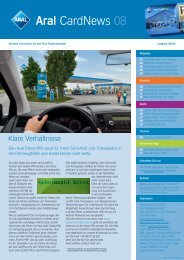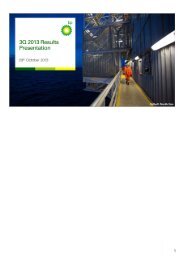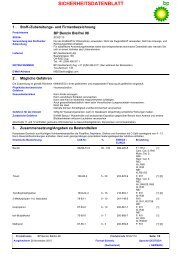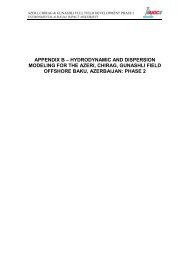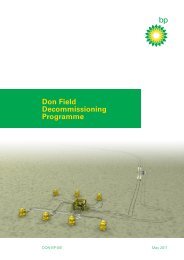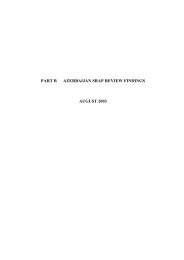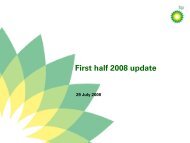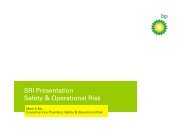BP in Angola Sustainability Report 2010 (pdf, 3860KB)
BP in Angola Sustainability Report 2010 (pdf, 3860KB)
BP in Angola Sustainability Report 2010 (pdf, 3860KB)
You also want an ePaper? Increase the reach of your titles
YUMPU automatically turns print PDFs into web optimized ePapers that Google loves.
Safety management The lessons we have learned from<br />
the tragic events <strong>in</strong> the Gulf of Mexico <strong>in</strong> <strong>2010</strong> are be<strong>in</strong>g applied<br />
<strong>in</strong> <strong>Angola</strong><br />
Safety management<br />
We recognise that <strong>BP</strong>’s ability to operate<br />
safely has been called <strong>in</strong>to question, and we<br />
are tak<strong>in</strong>g steps to strengthen the safety<br />
culture throughout our bus<strong>in</strong>ess, <strong>in</strong>clud<strong>in</strong>g<br />
here <strong>in</strong> <strong>Angola</strong> where we undertake<br />
exploration and production activities <strong>in</strong><br />
deepwater environments which pose<br />
significant technical and operational<br />
challenges.<br />
Our response to the Deepwater<br />
Horizon accident<br />
As part of the response to the <strong>in</strong>cident, our<br />
local management team <strong>in</strong> Luanda regularly<br />
contacted officials from the government and<br />
Sonangol to <strong>in</strong>form them of developments.<br />
The <strong>Angola</strong> bus<strong>in</strong>ess contributed the time and<br />
expertise of a number of personnel,<br />
temporarily re-locat<strong>in</strong>g staff to the Gulf coast<br />
region as part of the emergency response. In<br />
<strong>Angola</strong>, we subsequently ran a series of<br />
workshops to discuss the lessons learned,<br />
<strong>in</strong>volv<strong>in</strong>g M<strong>in</strong>istry officials, Sonangol, and<br />
<strong>in</strong>dustry organisations. These events were<br />
welcomed by the participants.<br />
In addition to these immediate actions,<br />
we <strong>in</strong>itiated a long-term programme of change<br />
cover<strong>in</strong>g organisational, procedural and<br />
cultural themes across the whole of <strong>BP</strong>.<br />
As our activities <strong>in</strong> offshore <strong>Angola</strong> are<br />
undertaken <strong>in</strong> challeng<strong>in</strong>g deepwater<br />
environments with similarities to those of the<br />
Gulf of Mexico, we reviewed aspects of our<br />
operations and emergency response<br />
capability.<br />
Manuel Xavier<br />
Junior<br />
<strong>Angola</strong> M<strong>in</strong>istry<br />
of Petroleum<br />
“The forum held <strong>in</strong> November <strong>2010</strong> <strong>in</strong><br />
<strong>Angola</strong> about the Macondo <strong>in</strong>cident was<br />
very useful. We were pleased that <strong>BP</strong> had<br />
brought <strong>in</strong> specialists who had been<br />
<strong>in</strong>volved <strong>in</strong> the <strong>in</strong>cident and response, and<br />
that they also had the opportunity to<br />
discuss other operations <strong>in</strong> other countries<br />
such as Brazil and Norway. My colleagues<br />
and I found it a valuable meet<strong>in</strong>g”.<br />
Well capp<strong>in</strong>g trial <strong>in</strong> <strong>Angola</strong><br />
A new procedure to cap deepsea wells <strong>in</strong> an<br />
emergency was trialled by the <strong>Angola</strong><br />
subsea operations team <strong>in</strong> May 2011. The<br />
capp<strong>in</strong>g plan is just one aspect of the wider<br />
<strong>BP</strong> response follow<strong>in</strong>g the Deepwater<br />
Horizon accident. The top priority is to<br />
prevent accidents and to enhance plann<strong>in</strong>g<br />
for a spill, should one occur, <strong>in</strong>clud<strong>in</strong>g the<br />
plann<strong>in</strong>g of cont<strong>in</strong>gent relief wells and<br />
upgraded oil spill response and crisis<br />
management plans.<br />
The new well capp<strong>in</strong>g device was tested<br />
on the Venus 1 wellhead <strong>in</strong> a water depth of<br />
more than 2,000m <strong>in</strong> <strong>Angola</strong>’s block 31.<br />
The capp<strong>in</strong>g device is a modified subsea<br />
assembly of valves, spools, and fitt<strong>in</strong>gs used<br />
to control flow. It was lifted back on board the<br />
oilfield subsea construction vessel Seven<br />
Seas after the operation.<br />
This means that the regional well<br />
capp<strong>in</strong>g plan is now live and able to be<br />
deployed offshore <strong>Angola</strong>, should it ever be<br />
required. The ground break<strong>in</strong>g project, the first<br />
<strong>in</strong> <strong>BP</strong> and the first for any oil company work<strong>in</strong>g<br />
<strong>in</strong> <strong>Angola</strong>, marked the culm<strong>in</strong>ation of five<br />
months’ work by <strong>BP</strong> <strong>Angola</strong>, supported by key<br />
contractors, Subsea 7, Oceaneer<strong>in</strong>g, FMC and<br />
Cameron.<br />
Multi-discipl<strong>in</strong>ary effort<br />
The project was supervised by Subsea 7 who<br />
co-ord<strong>in</strong>ated the multi-discipl<strong>in</strong>ary effort<br />
needed to produce the plan. The capp<strong>in</strong>g<br />
device was based on a concept from Don<br />
Allan, a <strong>BP</strong> wells subsea team leader, and<br />
Safety<br />
fabricated and assembled by Cameron and<br />
FMC at the Sonils base <strong>in</strong> Luanda.<br />
The plan provides for the capp<strong>in</strong>g device<br />
to be landed out onto the top of a blowout<br />
preventer from which the top part has been<br />
removed. The Venus 1 wellhead was selected<br />
for the trial because it has an identical<br />
connector size to that of the Discoverer<br />
Luanda blowout preventer.<br />
The <strong>BP</strong> subsea operations team’s support<br />
vessel, Russell Tide, deployed a Remote<br />
Operated Vehicle (ROV) to lock the well cap<br />
connector to the wellhead and to carry out<br />
post-closure monitor<strong>in</strong>g of the operation. When<br />
the device had been carefully seated onto the<br />
wellhead and locked <strong>in</strong> place, the Russel Tide<br />
and the ROV closed the well bore caps and<br />
then activated the system to power-up the well<br />
cap. Once the test had been satisfactorily<br />
concluded, the process was reversed and the<br />
device recovered to surface.<br />
Complete capp<strong>in</strong>g plan developed<br />
Over the five-month period lead<strong>in</strong>g to the<br />
successful tests, a complete six-part capp<strong>in</strong>g<br />
plan was developed, consist<strong>in</strong>g of plans and<br />
procedures, a seabed survey, subsea <strong>in</strong>jection<br />
of dispersant, debris clearance and site<br />
preparation, well capp<strong>in</strong>g operations and post<br />
well shut-<strong>in</strong> surveillance.<br />
The development of phase two of the<br />
plan will <strong>in</strong>clude the provision of equipment to<br />
accommodate the second rig, the Deepsea<br />
Stavanger, which will resume development<br />
drill<strong>in</strong>g <strong>in</strong> block18 later this year.<br />
Capp<strong>in</strong>g stack subsea acceptance test team onboard Subsea 7’s vessel, “Seven Seas”<br />
<strong>BP</strong> <strong>in</strong> <strong>Angola</strong> Susta<strong>in</strong>ability <strong>Report</strong> <strong>2010</strong> 17




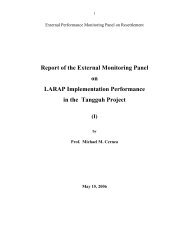
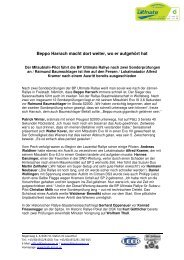
![[PDF] Deepwater Horizon: Accident Investigation Report - BP](https://img.yumpu.com/51697031/1/190x245/pdf-deepwater-horizon-accident-investigation-report-bp.jpg?quality=85)

